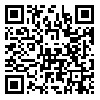Volume 71, Issue 6 (September 2013)
Tehran Univ Med J 2013, 71(6): 382-388 |
Back to browse issues page
Download citation:
BibTeX | RIS | EndNote | Medlars | ProCite | Reference Manager | RefWorks
Send citation to:



BibTeX | RIS | EndNote | Medlars | ProCite | Reference Manager | RefWorks
Send citation to:
Sedaghat M, Rashidian A, Hosseini S D. Is lumbosacral MRI in complemetary health insured patients, requested based on scientific guidelines?. Tehran Univ Med J 2013; 71 (6) :382-388
URL: http://tumj.tums.ac.ir/article-1-5427-en.html
URL: http://tumj.tums.ac.ir/article-1-5427-en.html
1- , drdhosseini@yahoo.com
Abstract: (9668 Views)
Background: The request for lumbosacral MRI in Iran based on previous studies is high (almost half of all MRI cases), so, our study is concerned with investigating the necessity of lumbosacral MRI request in patients with low back pain that is covered by complementary health insurance in Tehran through comparing MRI practice with valid guidelines.
Methods: Information of 274 complementary insured patients at Dana Insurance Company in Tehran, who had undergone low back MRI was studied. A portion of information in the questionnaire including age, sex, the physician’s field of specialty, and MRI report, was derived from the medical records. Other information based on guidelines indications, including duration of the prolonged back pain, record of associated infection, malignancy or trauma, saddle anesthesia, lower limb motor deficit and incontinence of urine or feces, was elicited from patients orally.
Results: Males represented 35% and females 65% of patients. Also, males were on average 10 years younger than females. Over 90% of MRI scans were requested by three fields of specialty (orthopedic, neurosurgery and neurology). Considering the indications of lumbar spine MRI request (prolonged back pain of more than one month duration, incontinence of urine or feces, lower limb motor deficit, saddle anesthesia, recent related trauma, infection and malignancy), approximately 20% of lumbar spine MRI scans were prescribed in accordance with guidelines.
Conclusion: Out of every five cases of lumbar spine MRI, four cases were not requested based on guidelines, suggesting needs for local guideline design and revising the manner in which MRI scans are prescribed for low back pain in complementary health insured patients in Tehran.
Methods: Information of 274 complementary insured patients at Dana Insurance Company in Tehran, who had undergone low back MRI was studied. A portion of information in the questionnaire including age, sex, the physician’s field of specialty, and MRI report, was derived from the medical records. Other information based on guidelines indications, including duration of the prolonged back pain, record of associated infection, malignancy or trauma, saddle anesthesia, lower limb motor deficit and incontinence of urine or feces, was elicited from patients orally.
Results: Males represented 35% and females 65% of patients. Also, males were on average 10 years younger than females. Over 90% of MRI scans were requested by three fields of specialty (orthopedic, neurosurgery and neurology). Considering the indications of lumbar spine MRI request (prolonged back pain of more than one month duration, incontinence of urine or feces, lower limb motor deficit, saddle anesthesia, recent related trauma, infection and malignancy), approximately 20% of lumbar spine MRI scans were prescribed in accordance with guidelines.
Conclusion: Out of every five cases of lumbar spine MRI, four cases were not requested based on guidelines, suggesting needs for local guideline design and revising the manner in which MRI scans are prescribed for low back pain in complementary health insured patients in Tehran.
Send email to the article author
| Rights and permissions | |
 |
This work is licensed under a Creative Commons Attribution-NonCommercial 4.0 International License. |





